In the past week we’ve been seeing lots of spots here, on our hillsides, in the meadow areas, and near the office. These spots…
One, two, three…awwwwww.
Some of you are no doubt well aware that our resident deer population has caused us more than a few headaches over the last the year as we’ve started to establish our orchard and gardens. We’ve spent many months installing, and reinforcing a perimeter deer fence, that has been breached over, and over, and over again. Surely the last thing we really need here, is MORE deer…but in their defense, our fruit trees probably are rather difficult to resist.
In November Curbstone Valley Farm became a Certified Wildlife Habitat, in part to help make others aware that conserving the land and all of its inhabitants here is important to us.
We love living here, and despite copious amounts of head-scratching, occasional cursing, and entirely too much time spent trying to protect a small orchard and garden area, we actually do enjoy seeing the deer here…just so long as they’re on the OUTSIDE of the small fenced in area around the gardens.
Earlier this spring we regularly saw a small gang of four young bucks, and a herd of five does wandering through the property. It didn’t take a genius to figure out some simple math. Four bucks + five does = at least a few fawns! It’s now late spring…and well…
…it seems that baby deer season is in full swing here at Curbstone Valley.
On Thursday, while out feeding the chickens, a different doe, this time with a pair of TWINS in tow, was sighted on the hillside near the chicken coop. Of course, I didn’t have my camera with me at that exact moment. However, Mom, and the juniors 1 and 2 wandered near our office about half an hour later.
Yes yes, the orchard is doomed, but sights like this outside of our windows really is why we chose to live here.
The remarkable thing is that this doe seems quite comfortable around us, and has brought her twins close enough to us that we can hear her low grunting sounds when she is communicating with her babies. She’ll leave them on a part of the hill, behind some brush or low shrubs, and then quietly call for them to join her when she feels it’s safe. This is the first year I’ve heard wild does audibly communicating with young, and it was fascinating to hear.
However, our burgeoning deer population points out just how much the ecology of the Santa Cruz Mountains has changed in the last 150 years. It’s difficult to imagine today that in the 1850’s grizzly bears and mountain lions were plentiful, and frequently sighted here. By the late 1800’s most of the bears that were once resident here had been hunted, and within 50 years their populations entirely extirpated. The last grizzly bear sighted in the Santa Cruz Mountains was a 642 pound sow bear, killed by Orrin Blodgett on Bonny Doon mountain in 1886 [1]
Mountain lions, in the last century, have had their populations significantly reduced, and their numbers are estimated to now range between 30-70 big cats throughout the entire Santa Cruz Mountain range. Their habitat is divided by roadways and fences, and their future is constantly threatened by ever growing human populations [2]. The last actual sighting of a mountain lion here on our property, was reported to be a couple of years before we moved in.
With the bears gone, and mountain lion populations significantly reduced, the deer really have little to worry about here beyond a couple of crazed gardeners running toward them occasionally, waving their arms. They are so plentiful here because there aren’t many predators left to keep their populations in check.
We do have Bobcats, and Coyotes here, but neither pose particularly strong threats to the deer population, except for the young fawns. Their greatest predator is probably the vehicles on our roads. As shown in the video below, our Bobcats seem content to catch gophers rather than large prey.
All this makes us aware that while we’re trying to preserve the majority of our land, and not detrimentally alter the delicate balance of plants, fungi, insects, and animals on the property, that even this small piece of land here has become somewhat out of balance in recent decades.
We can’t restore all that has been lost to human intrusion, but we can appreciate and enjoy what remains, and strive to conserve the rest the best we can.
——————
[1] Taber, Tom (1998) The Santa Cruz Mountains Trail Book
[2] Bay Area Puma Project

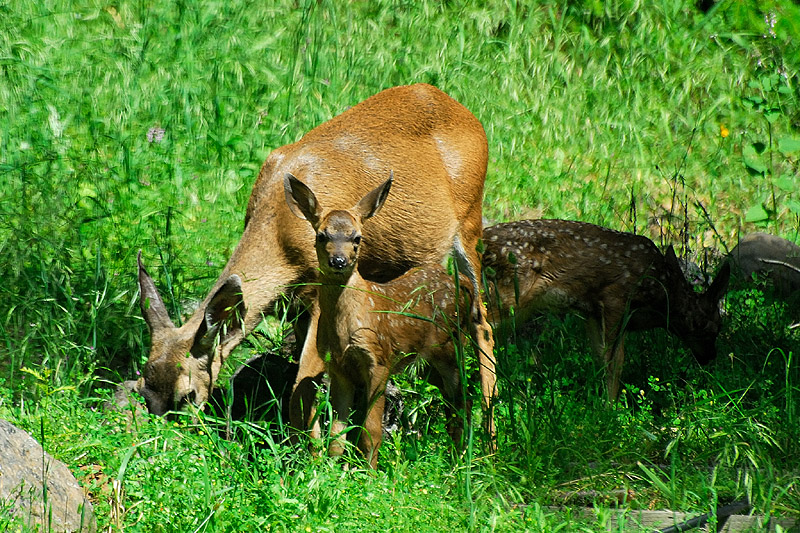
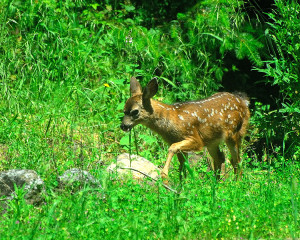
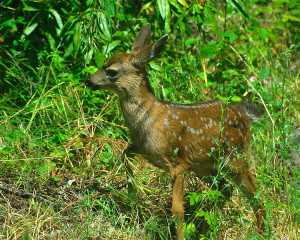


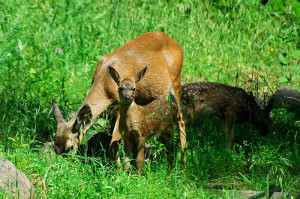

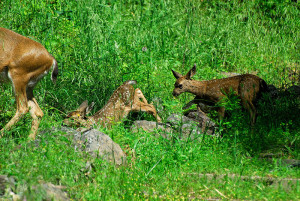
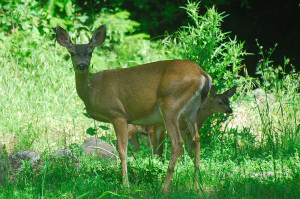







Dear Clare, Grizzly Bears, Mountain Lions or deer…..I will readily admit that I should settle for the deer. And, what beautiful and healthy deer they look too.
I can see the point you raise so well here of the delicate balancing act in trying to maintain an equilibrium with nature. But, I do believe that you are really trying hard and are a shining example to us all to do what we can in our own small corners of the world.
Edith, they are most healthy deer! I agree, I wouldn’t want to bump into a grizzly any more than I’d like a run-in with a mountain lion. The lion though is still a possibility, and it’s a risk I accept by living here, and keeping livestock here. It’s just unfortunate that as a species we have this propensity for killing that which we fear, or do not understand. We’re living in lion country…it’s not the other way around. It still astonishes me how quickly we’ve been able to eliminate species, at least regionally, in the past. I hope we’re smarter now…but sometimes I wonder.
Those are splendid creatures! Well, at least they are to my eyes. How wonderful to see those precious spotted fawns. It does seem the population may have risen to nuisance level there, since they have no predators. Don’t think I’d want to live with grizzlies around though.
They are splendid creatures, and fascinating to watch (and listen to). It’s not their fault they’re so successful in the absence of their chief predators. Although we do often see injured or weakened deer, that if the predators were present, would be culled from the herd. We had one deer here that could only walk on three legs, that survived through two winters. I’m assuming there were no lions nearby during that time! 😛
How wonderful Clare to have a view like this outside your office window – reminds me of Walt Disney’s Bambi. I really do hope that your fence deters these youngsters when they are a little older and able to jump.
With the deer not having any predators I am sure many of your native flowering species find it hard to survive the constant grazing.
A lot do struggle, although some are left untouched. They don’t bother the Mimulus species. My native poppies though have certainly struggled. I’ve seen them dragged below by gophers, and mowed to the ground by deer. I’m amazed sometimes that California has any native poppies left! I barely had enough left to do the blog post about them this spring! We’ll try actually planting some in the autumn within the deer fence, and see if they fare better.
Hi Clare, the fawns are beautiful…And,it is amazing how you are learning to live among them and have your orchard. My front garden is open to the deer. But it is so fragrant that I see the deer walk by. Not until fall do they enter again in it. I hope that continues to hold true, because I planted a veggie bed in front. We will see 🙂
Hi Clare,
I envy you living in such a beautiful spot. How anyone can shoot a deer I have no idea. If only we could get everyone to care about what is in their back yards….maybe, just maybe they’d care about what is in the world. Ahhh I’m getting all serious. I haven’t had a drink tonight, that would be the issue. Take care, M
Clare, the college I went to had a huge part of its endowment in acreage, and part of that was a wildlife preserve — but they constantly had issues with the deer. They were practically forced to have a periodic culling of the herd, in order for the remaining animals to be healthy. One misty morning, heading to class via a shortcut that took me past a field, I stopped short in my tracks to survey 80+ (stopped counting) deer rising ghostlike from the fog hovering there, and many of them looked quite skinny. I’ve never forgotten the lesson: predators are important. (Altho what does this say about man?)
Still, could a fawn be any cuter or sweeter? Who could wish a predator on them? That second photo, enlarged, just melted my heart. 🙂
My goodness! What a butt-windup and sproingy pounce! One of my coworkers was passed by a mountain lion while hiking in Las Trampas, and I’ve seen a bobcat just outside the Fitzgerald Marine Reserve. But in the back yard?!?!?
Zowie.
‘Bob’ is actually a very common sight here…much to the chagrin of our chickens! Although, as he seems so expert at catching gophers…I’m more than happy to have him around.
Deer, oh dear! But I can totally relate because that’s precisely why we moved out to the boonies from suburban LA so that we could be one with the bunnies, coyotes, mule deer, bobcats, gray foxes, raccoons, mountain lions, and other countless critters. You should see the garrison of chicken wire around all my vulnerable plantings that I’ve erected to keep the local nibblers at bay. Chicken wire: an unfortunate necessity. But wildlife viewing: priceless.
The Santa Rosa Plateau happens to be a Mountain Lion corridor and the semi-annual native plant sales here help to support a collaring program via UC Davis to track and research the habits and wanderings of our native feline. It’s all good.
UCSC Santa Cruz has a similar tracking program up here. The Bay Area Puma Project is affiliated with a UCSC researcher I believe. I hope that these studies will enable people not to just better understand these cats, but also to have more tolerance for them. Sure, I don’t want to stand inches from one in the wild, but I’m more than happy to give them their space. If they take occasional livestock, it’s part and parcel of the risks of choosing to live here. As farmers, it’s our responsibility to expect it can happen, and protect our animals accordingly. Not unlike protecting our lettuce from the deer and rabbits!
‘hear the doe calling’ I remember, just once, we were at Gordon’s Bay, traffic stopped all over the coast road. There were whales in the bay, and we, standing by the car, could hear them calling.
That sounds like a wonderful experience Diana. I’m always fascinated with how animals communicate to each other, and especially to their young. The amazing thing was these fawns actually seemed to listen to their mother 😛
I know the dear can be quite a problem for you, but as I don’t see them very often anymore, I relish your photos! The fawns are adorable!
Oops…I mispelled deer! 🙁
Can I borrow your bobcat? Our feral cats seem useless when I comes to the gophers. They would apparently rather chase lizards.
Lovely photos of the fawns! Thanks for sharing them.
I think I squealed when I saw this Bobcat come up with a gopher, it’s the first time I’ve seen a Bobcat actually catch one! The gophers are rather out of control here. There seems to be a waiting list for ‘Bob’ though…there are a lot of us that could put him to good use! 😛
Wow, what a great post. I love your little neighbors.
In the first year we lived in our house, sometimes a deer came visiting us… But here in Belgium they are so few they never cause problems in the garden. (The rabbits caused more damage in those early years…)
We have bunnies too…and they can eat a LOT for being such small creatures. Thankfully, at least so far, they seem content to browse on our weeds, and leave our other plants alone.
We had twins around last summer. They and mom were so tame I could walk right up within 25 ft or less without spooking them. I was concerned because they regularly cross the road in front of our house, and most of the drivers seem oblivious to the fact there are deer standing a few feet from the road.
It’s not a good situation, but they have lost so much habitat here that they have moved into the subdivisions, which is what surrounds us. And our 1.5 acres is not enough to sustain a herd of deer even if we wanted to.
It’s a scene that is played out all over, I am afraid.
That’s a good point villager, and we had similar conversation between ourselves over coffee this morning. We actually don’t know that the deer population is necessarily higher now than it was in the 1850s. In fact, it could be the same, or less, but because of habitat encroachment, the DPO (Deer Per Orchard) probably is higher, in that they are concentrated in smaller areas. We have absolutely no intention of fencing off any more of our property than just the small orchard and garden, so we don’t restrict any more range than necessary for all the species that live here, whether they’re quail, bobcats, or deer.
Hi Clare,
Your photos would surely soften the heart of anyone who might be frustrated about having a ‘deer problem.’
Bobcats and coyotes sound like a challenge! I’ve always wanted to spy a bobcat, but I’m clearly not living or hiking in the right places. I thought I might have seen one when I was hiking in Pt Reyes before we moved here. But I’ve never been certain.
My urban roots still tingle a bit when I hear ‘mountain lion,’ but you sound like such a benevolent steward of your piece of the earth.
Kudos to you!
(and oh my, you have a sophisticated web site… as I type, an automated system just linked to my latest post. I thought I had hit the wrong key;~D
Ah, that’s the CommentLuv widget, it grabs the link to your last post automatically.
I’ve been fortunate to see a few Bobcats up close, both here, at Long Marine Lab, and Wilder Ranch. The ones here upset the chickens though I love seeing them around, and oddly enough, I’ve seen them most often during daylight hours, mostly early mornings, or late afternoon. Last summer we had a male that wandered through about 3:45 PM every afternoon, like clockwork!
So cute! You are fortunate to observe wildlife closely!
A state park near my home actually lets hunters come in with bows and arrows to shoot deer on certain days each year to keep the population in check. This policy was adopted after many of the deer suffered from disease and malnutrition due to overpopulation.
A lovely post, Clare. I like to think we live in ‘their’ house so what will be, will be. Just returned from our lake cottage where, as it should be, black bears, coyote, bobcats, deer, bald eagles, loons rule … we must adjust knowing we are sharing this beautiful piece of earth. We never feed wildlife … happy when they don’t nibble on ours 🙂 When the population gets out of hand, in the hands of professional hunters, I close my eyes honoring the law of the land …
I think they look very cute and adorable. Such a dear.
I’m reading the letters of William Brewer who was part of the California geological survey team in 1860-4. He writes to his brother back east and is quite lively and detailed in his description – many many descriptions of plentiful grizzly bear tracks. He says they sleep comfortably as there is no known case of grizzlies attacking a person in their sleep – but he is very wary of bumping into them during their daily hikes to the tops of vs. peaks to do measurements etc. And he kills a lot of animals quite needlessly. Saw a skunk. Killed it. Saw a rattlesnake. killed it. On it goes with no thoughts or considerations of consequences – assuming these critters will be abundant forever I guess. There are always a few, deer here, but never many. We have more lion presence here – seen in the neighborhood once or twice a year it seems, and killing goats nearby. A mother and son have been spotted. My neighbor worries the mother is teaching her son how easy it is to get nice fat goats to eat. I also worry about balance, but really, wherever humans go, balance seems to be out of the question. We do our little bit here. I just hope I’m not acting badly out of ignorance.
Bobcat kitty, I want to pet you! (in theory, in theory!) He’s just so absolutely adorable, I couldn’t help but squeal with delight watching the video!
Gardening for wildlife in your neck of the woods gets pretty extreme- what plants attract mountain lions? Lol!
Deer weed? 😛
Our deer population exploded with the demise of the small dairy farms. While the best crop land was absorbed into ever larger farms there were still 1000s of acres of ‘marginal’ land left to go wild. 40 years ago you were lucky to see a deer, today you’re lucky to get home from town without totaling the car.
I looked out my ‘office’ window yesterday and saw a doe eating the phlox not more than 4 feet away. In winter they ring the doorbell and ask for handouts.
If our deer figure out how to ring the doorbell…heck, might as well just give them house keys at that point, and show them to the fridge! 😛